Georgian-Abkhaz war 1992-1993: bleeding wound
Twenty years ago, the war began in the territory of Abkhazia, which is still causing fierce disputes among military, historians, journalists, politicians and other interested people about the status of the campaign. The official Abkhaz authorities call the 1992-1993 war the Abkhaz Patriotic War, in which they were able to defeat the Georgian occupying forces and declare the existence of Abkhazia as a state claiming independence to the world. The Georgian leadership and many of the ethnic Georgians who fled Abkhazia during that war express the view that the war in Abkhazia is a conflict, which the Kremlin, which decided to act on the principle of “divide et impera” or “divide and conquer. " But fundamental disagreements over the status of that war are fading compared to what disastrous consequences of the humanitarian and economic plan the Georgian-Abkhaz confrontation of the 1992-1993 model has led to.
If we talk about the beginning of the Georgian-Abkhaz military confrontation twenty years ago, then both Sukhum and Tbilisi speak about the same event that served as the “first sign” of the conflict. However, this event is completely differently interpreted by the parties.
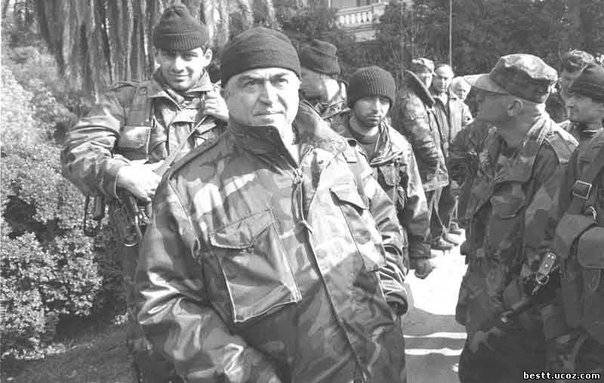
The conflict began with the fact that the first divisions of Georgian troops under the command of Tengiz Kitovani (then Minister of Defense of Georgia) entered the territory of Abkhazia allegedly in order to protect the Ingiri-Sochi railway. The operation was called the “Sword” (somehow too pathetic for the protection of a conventional railway). About 3000 Georgian “bayonets” were thrown across the administrative border, five tanks T-55, several Grad installations, three BTR-60 and BTR-70, Mi-8, Mi-24, Mi-26 helicopters. Around the same time, the Georgian fleet conducted an operation in the waters of the city of Gagra. This included two hydrofoil boats and two ships, which Tbilisi called landing. The ships approaching the shore did not arouse any suspicion, since Russian flags fluttered over them ... Georgian troops landed on the shore in the amount of several hundred people who tried to occupy strategic targets by means of a quick attack using an automatic weapons.
The Georgian authorities said that in the territory of Abkhazia, whose status by then the local authorities were going to define as federative relations with Tbilisi, there are gangs that participate in the incessant looting of railway trains and terrorist acts on the railroad tracks. Explosions and robberies did take place (it was not denied by the Abkhaz side either), but the Abkhaz authorities hoped to restore order by their own efforts after the settlement of the republic’s status. That is why the entry of units of the Georgian army into Abkhazia, which included not only regular military personnel, but also amnestied criminals of various stripes who returned to power Eduard Shevardnadze, official Sukhum called the purest provocation. According to the Abkhaz side, Shevardnadze sent troops into the republic in order to prevent the decree on the sovereignty of Abkhazia, which was adopted by the local legislative body (Supreme Council), from being translated into reality. This resolution was consistent with the Constitution of the 1925 model of the year, in which Abkhazia was spoken about as a sovereign state, but as part of the Georgian Soviet Socialist Republic.
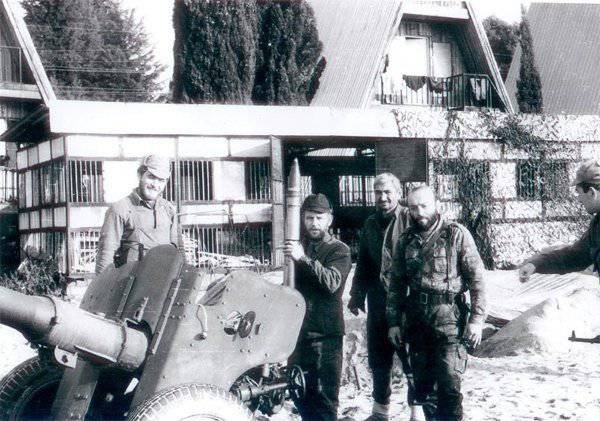
Such a situation with the declaration of the de facto independence of Abkhazia was not satisfied by official Tbilisi. This, according to the Abkhaz capital, was the main reason for the start of the Georgian operation against the Republic of Abkhazia.
For more than 13 months, the war in the territory of Abkhazia went on with varying success, taking the lives of not only soldiers of both the Abkhaz and Georgian armies, and a large number of civilians. According to official statistics, casualties on both sides were about 8000 killed, over a thousand missing, about 35 thousand people were injured of varying degrees of severity, many of whom died from injuries in hospitals in Georgia and Abkhazia. Even after the announcement of the victory of the Abkhaz army and its allies over the Georgian troops in the republic continued to die. This is due to the fact that in many areas of Abkhazia minefields remained unliquidated, which at one time were created by both sides. People were undermined by mines not only on Abkhaz roads, pastures, in cities and villages of the republic, but even on the beaches of the Black Sea coast.
If we talk about what forces besides the Abkhaz and Georgians took part in the military conflict, even the participants of the events cannot give a precise and exceptionally complete answer. According to the materials made public several years after the end of the conflict, it turned out that, apart from regular military and local militias, the KGB Cossacks, volunteer detachments from Transdniestria and representatives of the Confederation of Mountain Peoples of the Caucasus supported the Abkhaz side. The Georgian side was supported by the detachments of the National Socialists of Ukraine (UNA-UNSO), whose representatives were subsequently awarded high honors to Georgia for military valor.
By the way, it is worth noting that units of the Ukrainian nationalists took part in the Transnistrian conflict on the side of Tiraspol shortly before, but on the territory of Abkhazia the Transnistrian and Ukrainian nationalist units were on opposite sides of the front. Representatives of the UNA-UNSO, commenting on the situation that had developed by that time, say that their support for Georgia in the confrontation with Abkhazia began with the appearance of information about the support of Abkhazia from Russia. Obviously, the word "Russia" for every Ukrainian nationalist is the main life irritant, so for the UNA-UNSO fighters it was, in fact, not important against whom they are fighting, the main thing is that from the opposite side there is information that there are Russians ... By the way, ethnic Russians, according to publications in one of the nationalist magazines, fought on the side of Georgia. We are talking about the arrows that were part of the units of the very Ukrainian national self-defense. At least four of them are buried in the Baikovo Cemetery of Kiev.
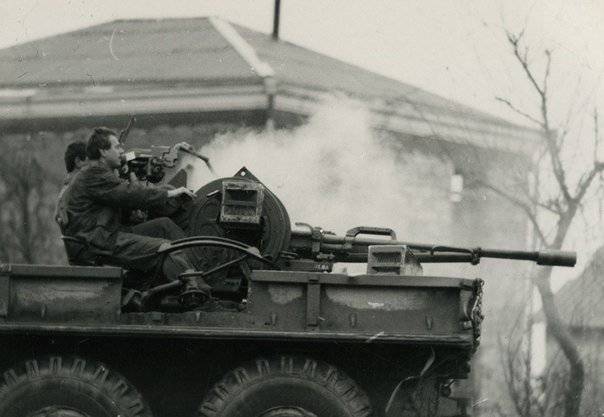
If we talk about the role of Russia in the Georgian-Abkhaz war of 1992-1993, then there is still heated debate over this role. According to the opinion that has taken shape in 20 years, the Kremlin supported the Abkhaz authorities and did not support Shevardnadze, which helped the Abkhaz to defeat the Georgian army. On the one hand, Sukhum’s support for Moscow took place, but it did not have official status. Even the air sorties from the Russian side were later called “volunteer”, because no one gave any orders to help Abkhazia from the air. This can be called cynicism of the Yeltsin era, but so far there are no official documents that orders to military pilots were actually given at the Russian Ministry of Defense.
But Moscow’s support for Sukhum was manifested far from the first stage of the campaign. As long as Georgian tanks and “batteers” “ironed” Abkhazia, Boris Yeltsin kept silence, like the entire world community, to which the Abkhaz leader Vladislav Ardzinba tried to shout in order to intervene and stop the bloodshed. However, the world community was, as they say, damn what was happening there in Abkhazia and where Abkhazia was in general, since the main goal, the disintegration of the USSR, had already been achieved, and the rest of the world’s leaders cared little. Boris Yeltsin, if you are guided by materials about his unwillingness to respond to the Abkhaz president, apparently had his own plans for this campaign. According to many experts, the Kremlin needed the war between Sukhum and Tbilisi in 1992 in order to draw Georgia into the CIS and adopt new agreements on the supply of Russian weapons to Tbilisi. However, Shevardnadze, who at that time was the Georgian president, could hardly give such guarantees to Yeltsin. He could not give them, because in 1992, Georgia was a real patchwork blanket that cracked at the seams: Abkhazia, Ajaria, South Ossetia, Megrelia (Mingrelia), and therefore not controlled from Tbilisi not only de facto, but often even and de jure ...
Relying on the fact that a “quick victorious war” will solve this problem and allow Georgia to become a full member of the CIS is absurd because the CIS itself at that time looked like a rather ambiguous entity in the post-Soviet space.
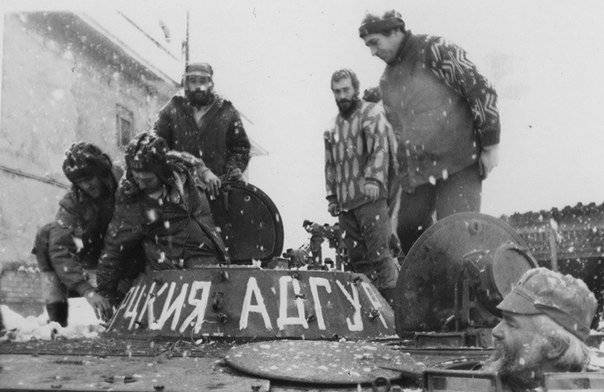
In the meantime, Boris Nikolaevich “deigned to think,” the ships of the Black Sea fleet rescued civilians, taking them from the territory of Abkhazia to safer places. At the same time, not only ethnic Abkhazians and Russians were exported, as official Tbilisi tried to imagine, but also residents of the republic of other nationalities (including Georgians from among civilians), as well as thousands of vacationers who, at the height of the holiday season, were in the present military boiler.
While Boris Nikolayevich “still deigned to think”, there were more and more provocations by the Georgian side against Russian warships stationed in Poti. The base was constantly subjected to attacks that led to open skirmishes between Russian sailors and attackers.
At the beginning of autumn 1992, the Georgian military began to speak openly that in fact the war was fought not so much against Abkhazia, as against Russia. This was stated, in particular, by the senior naval commander of the Poti garrison, captain of 1 rank Gabunia.
Apparently, the position of the Georgian side, at last, was evaluated in the Kremlin, after which Boris Nikolayevich still “decided” ...
The end of the armed conflict came in September 1993. The economic losses of Abkhazia were such that so far this republic cannot come to a normal rhythm of life. Infrastructure facilities were almost completely destroyed, communication lines, roads, bridges were damaged, educational institutions, sports facilities, and houses were destroyed. Tens of thousands of people lost their homes and were forced to either leave Abkhazia for Russia, Georgia and other countries, or try to start life from scratch in their native republic.
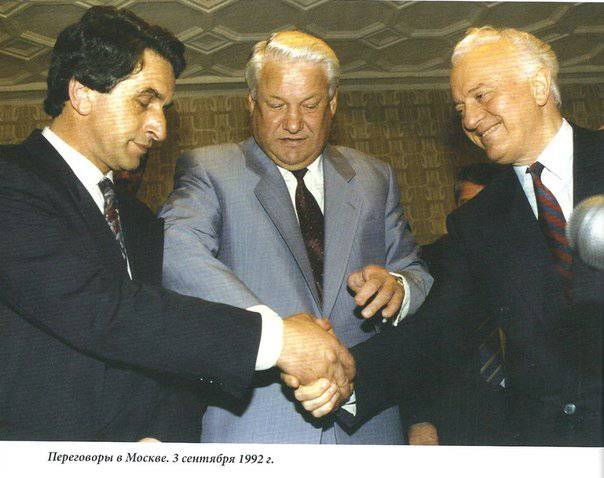
This war has become another wound that has been exposed since the collapse of the USSR. The peoples, who lived side by side in peace and harmony for a long time, were forced to take up arms through the fault of those who called themselves politicians, and in fact represented the most genuine state criminals.
This wound is bleeding now. And who knows when it comes to stories the day when a full-fledged peace will prevail in this region? ..
Information